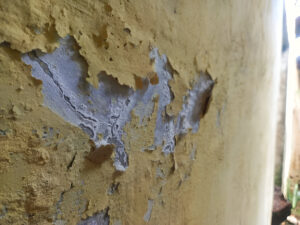If you’ve just found out that your building has failed a lead inspection, take a step back and a deep breath — you’re not alone.
So many homeowners and building owners in NYC have faced a violation at one point, and the silver lining is that it’s totally fixable. Yes, lead violations can seem quite overwhelming at first glance, but with the right team in your corner and a step-by-step approach, you can turn this around.
We’ll walk you through what it means to fail a lead inspection in NYC, how to identify areas that need attention, and what steps you need to take moving forward.
What Does a Failed Lead Inspection Mean?
Local Law 1 in NCY makes it mandatory for landlords to inspect apartments for lead-based paint hazards in buildings built before 1960.
If you failed a lead inspection, it means that an inspector found lead paint hazards that exceed allowable limits or present a risk to tenants, especially children under the age of six.
Lead violations are serious — yes, the legal implications can seem daunting, but the health risks that come with them are just as detrimental. Did you know that lead exposure can cause severe developmental delays in children, damage to the brain and nervous system, as well as other long-term health issues?
Definitely not something to take lightly.
Reasons You Might Fail a Lead Inspection
Here’s a look at some of the common reasons that cause a failed lead inspection.
- Chipping or peeling paint
- Poorly maintained painted surfaces
- Lead dust found on floors or window sills
- Poor repainting was done without certified professionals
Step-by-Step Guide on Repairing a Lead Failed Inspection Area
1. Review the Violation Notice
The NYC Department of Housing Preservation and Development (HPD) usually issues the violation notice. Make sure to go through it carefully and thoroughly. This notice will include everything you need to know about which areas have failed and what sort of remediation you’ll need.
2. Hire an EPA-Certified Lead Abatement Contractor
This step is arguably the most important. Only EPA-certified professionals are legally allowed to handle lead hazard repairs, so DIY simply won’t work here.
A certified contractor will:
- Assess the severity of the hazard
- Help you create a remediation plan
- Use lead-safe methods to remove the lead hazard completely
Also Read: Top 5 Violations That Trigger a Local Law 31 Lead Paint Inspection
3. Contain and Prepare the Work Area
Before the actual work begins, the area must be properly sealed off to prevent contamination. This includes:
- Plastic sheeting over floors and furniture
- Air filtration systems
- Signage to prevent unauthorized entry
4. Remove the Lead Hazard
Depending on the issue, the procedure can include:
- Sealing the lead paint via encapsulation
- Replacing affected window frames or baseboards
- Paint stripping
The method depends on the extent and location of the lead paint hazard.
5. Cleanup and Clearance Testing
Once you’re done with the repairs, the cleaning process starts. For this, you’ll need HEPA vacuums, wet-wiping, and dust sampling. Once the cleaning is done, a certified inspector will perform clearance testing to check whether or not the area is safe.
You might be tempted to cut corners here, but make sure not to! The clearance test is important for clearing the failed inspection.
6. Submit Proof and Paperwork
Once you pass the clearance test, you’ll receive documentation, which you need to submit to HPD or any appropriate agency to prove the violation has been corrected. Make sure not to delay this step, since you might be fined!
What Happens If You Ignore a Lead Violation?
If you want the honest answer: nothing good.
Fines can start at hundreds of dollars and climb into the thousands if the issue remains unresolved. You could also be sued by tenants, face difficulty selling your property, or be required to temporarily vacate tenants.
Lead violations can lead to criminal charges if negligence results in health problems.
All in all, you do NOT want to ignore a lead violation.
Tips on Making Your Journey Through a Failed Lead Inspection Easier
- Stay organized. Keep every document, photo, and report. You’ll need it later, even if you think you don’t
- Make sure to act fast. The faster you start, the less risk of fines or tenant issues.
- Work with professionals. No matter how much anyone convinces you otherwise. This isn’t the time to cut corners.
- Budget wisely. Lead repairs aren’t cheap, but neither are the penalties.
A Lead Failed Inspection is Fixable
We get it. Getting a lead inspection violation might seem like the end of the world, but it really isn’t. When you’ve got the right team and follow the right steps, you can fix this.
If you’re not sure where to start with a lead inspection in NYC or need trusted professionals to guide you through the process, Manhattan Lead is just a call away. Get in touch with us and get back on track!




